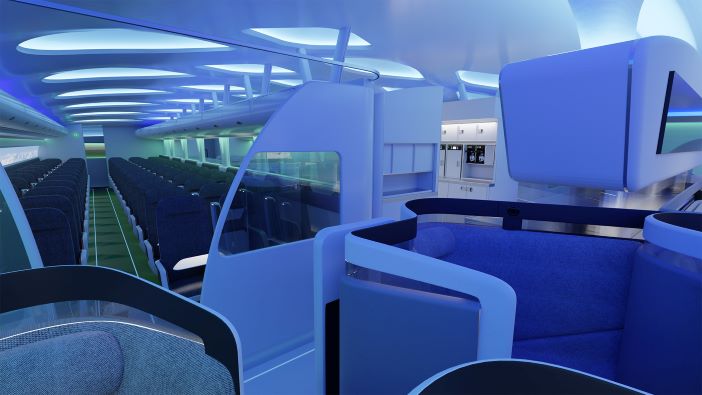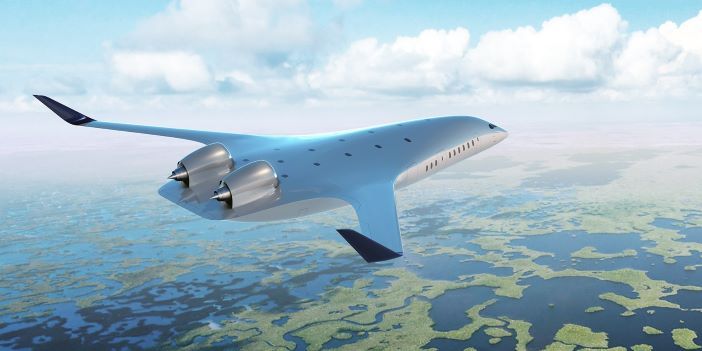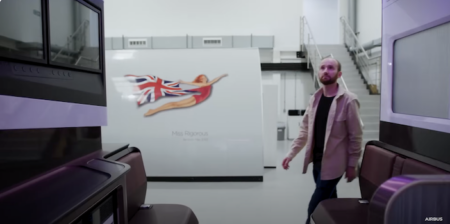A possible glimpse into the future of aircraft interiors has been revealed by JetZero, which would move cabin design from the conventional tube, to a more open space with new potential for the passenger experience. The proposal is a blended wing body (BWB) aircraft that reduces weight and drag through the elimination of the conventional airliner tail section, effectively operating as one huge wing, which reduces surface area and weight.
Benefits of this shape include the generation of enormous amounts of lift, reduced noise, aerodynamic efficiency, and thus fuel efficiency – JetZero claims up to 50% better fuel efficiency. The company envisions that the aircraft will initially be powered using traditional jet fuel or sustainable aviation fuel (SAF), with potential to be adapted to hydrogen propulsion in the future.
BWB concepts are not new, but JetZero means business, having been founded in 2021 with the aim of developing the next generation of sustainable jets, as aviation strives to achieve net zero emissions by 2050. The core of the JetZero team, based at Long Beach Airport in California, brings engineering experience in the BWB field, including founder and CTO Mark Page. As a McDonnell Douglas programme manager in the 1990s, Page led a three-year NASA initiative to investigate and design future BWB properties. NASA since that time has spent more than $1 billion on R&D of blended wing technology.
The interiors
The exterior of the aircraft is striking, but the interiors perhaps even more so. JetZero has worked with the Factorydesign studio to maximise the potential opened up by the internal volume of the BWB, which is far greater than that within a conventional ‘tube and wing’ fuselage.

According to Factorydesign the aircraft interior has been inspired by regenerative design principles more commonly used in ultra-modern building design. In basic terms, this means that the cabin structures are designed and optimised to provide strength where it is needed, which can open up cellular gaps appear where strength is not needed, saving weight. This approach means the cabin can be lit by overhead and front side windows, with many apertures in-between the structural elements that flood the cabin with light and space.
In terms of the layout of passenger accommodations (LOPA), the broad cabin space enables multiple seating areas to be positioned within the centre of the aircraft. The cabin concept is currently shown with relatively standard aircraft seat products, but there is ongoing activity at Factorydesign as they explore ways to completely redefine the commercial passenger flying experience. The interior space would also give designers more flexibility in working with airlines on their preferred galley, lavatory and seating arrangements.
The space is certainly large and would create a great feeling of space. Almost too big a feeling if not carefully considered, and indeed Factorydesign’s renderings show ideas of how to split the space into zones and more intimate spaces.

“Aircraft technology has advanced hugely over the last 60 years; however, the opportunities for improved efficiency are reducing,” stated Peter Tennent, director of Factorydesign. “The same is happening in cabin interiors, as decades of attention means opportunities in tube and wing aircraft to create unique passenger experiences are becoming increasingly elusive. Significant and beneficial step-change to the passenger flying experience will only come with a revolution in aircraft, and the JetZero blended wing aircraft is exactly that.”
The design teams have also been investigating how the latest high-definition displays could be used to form cabin sidewall panels, on which images could be projected, such as window frames with a view, or full-length animated panoramic views of the passing sky.
We have added more images of the project into our Gallery page.
“The blended-wing shape offers a unique opportunity to move past the space constraints of tube-and-wing aircraft, raising the bar for passenger and crew comfort. We are delighted to have Factorydesign on-board to help JetZero create a future flying experience that passengers will love,” stated Tom O’Leary, co-founder and CEO of JetZero.
Across the Atlantic, a consortium is looking at how the net-zero passenger experience could develop for larger-fuselage aircraft. You can find out more about the FlyZero cabins HERE.





